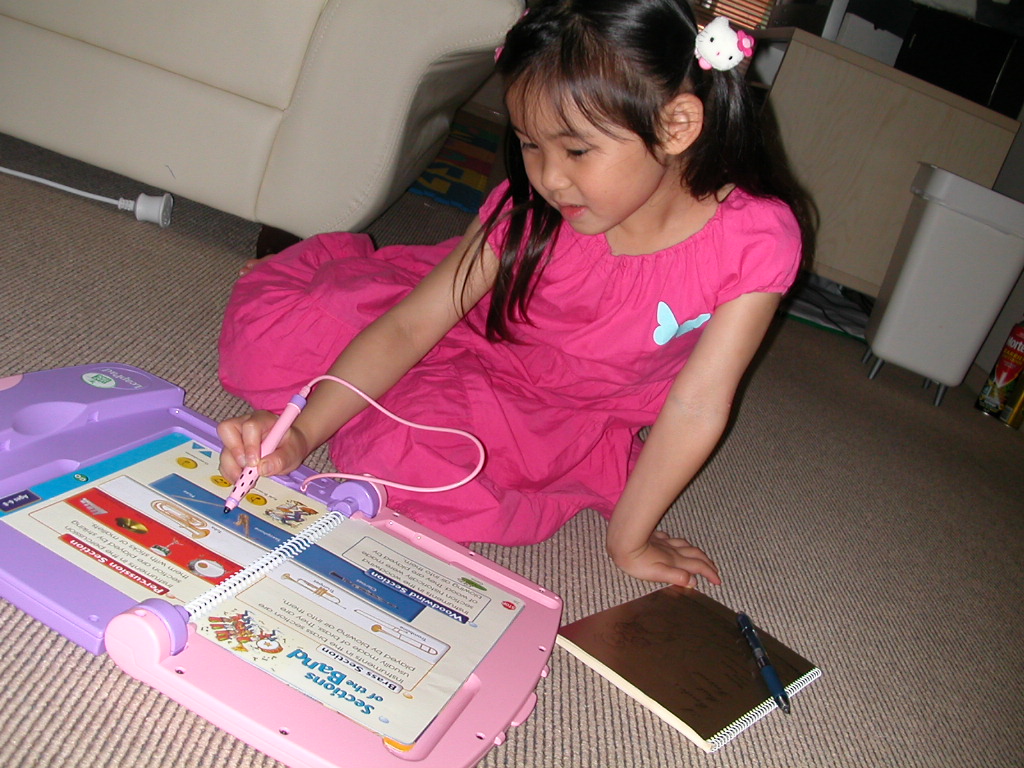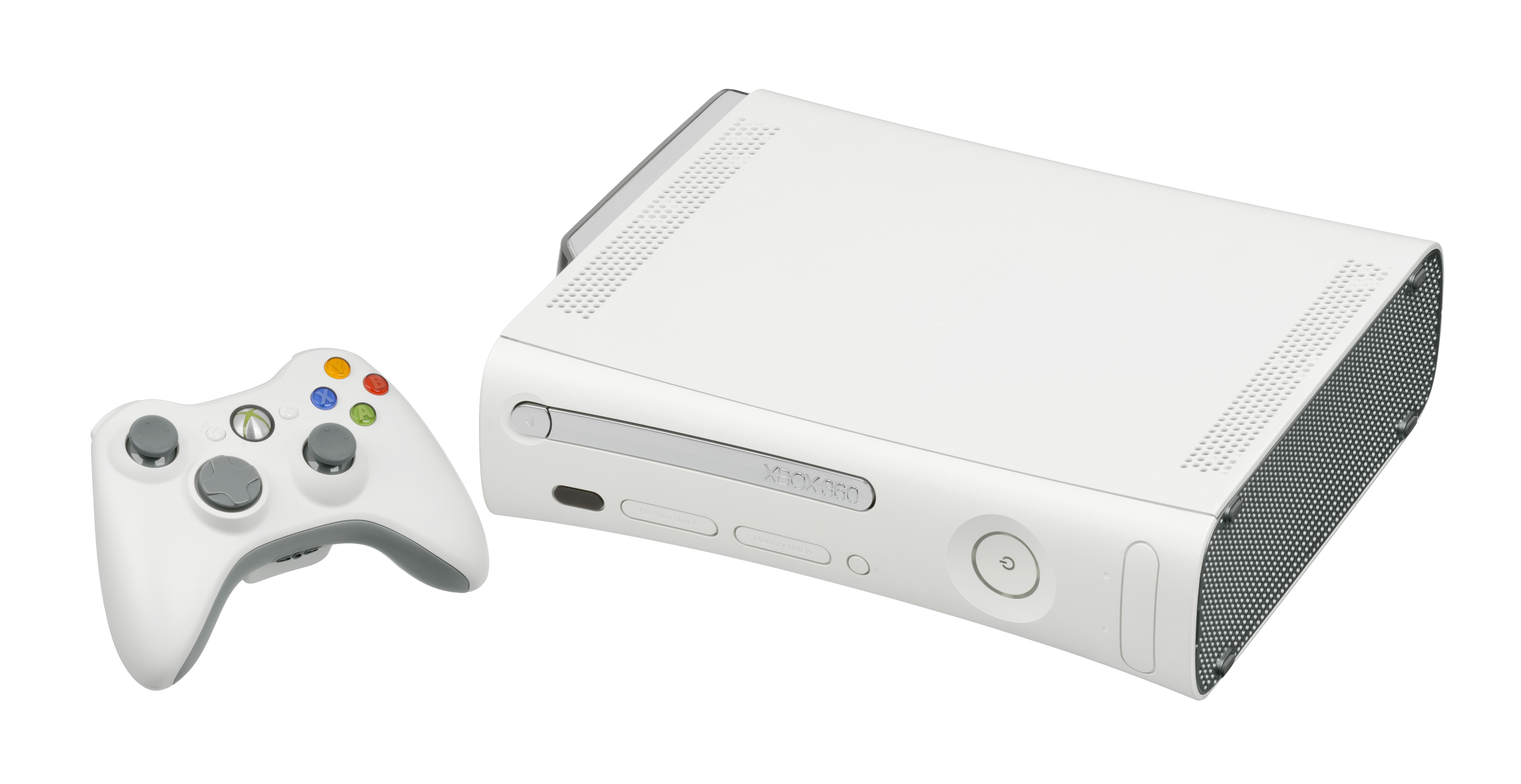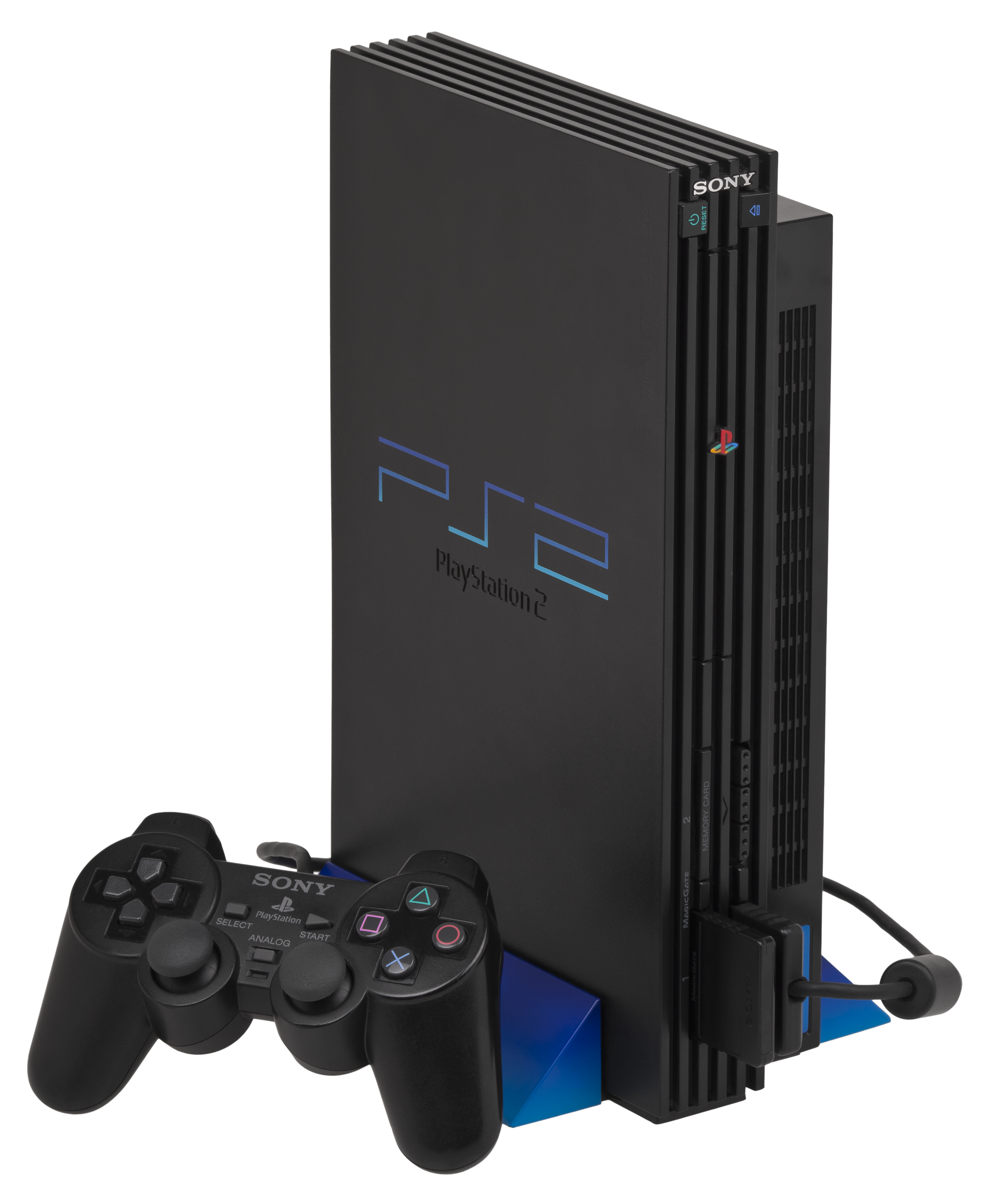|
Leapster
The Leapster Learning Game System is an educational handheld game console aimed at 5 to 10-11 year olds (preschool to fourth grade), made by LeapFrog Enterprises. Its games teach the alphabet, phonics, basic math (addition, subtraction, multiplication, division), and art and animal facts to players. Along with a directional pad, the system features a touchscreen with a stylus pen that enables young users to interact directly with the screen. LeapFrog released the Leapster2 handheld device as a successor to the Leapster in July 2008. The Leapster2 is essentially the previous system with an added USB port and SD card slot. These additions give the ability to play a downloaded full game or short game including the ability to log data on gameplay, such as what has been learned by the user or art created by the user. Downloadable games are not for sale. In June 2010, the Leapster Explorer was released, thus ending the original Leapster line. The games released since the Leapster2' ... [...More Info...] [...Related Items...] OR: [Wikipedia] [Google] [Baidu] |
Leapster Explorer
The Leapster Explorer is a handheld console developed and marketed by LeapFrog Enterprises as the third generation of the successful Leapster series. It is aimed at children aged 4 to 9. In June 2012, new versions of the Leapster Explorers were announced, set to be released on July 18 of that same year. The update was branded the LeapsterGS Explorer and it has higher resolution front and back cameras, longer battery life, 2GB of memory, and an LF 2000 processor. Hardware The Leapster Explorer is a Linux device powered by an ARM9-based processor clocked at 393 MHz with 64 MB DDR SDRAM, 512 MB user storage, and a Giantplus touchscreen display. For the LeapsterGS Explorer, it is powered by a LF 2000 processor clocked at 550 MHz with 128 MB DDR SDRAM, 2GB memory storage, a new thinner sleek design, larger screen, and a bult-in megapixel camera as well as a motion sensor. Like the Didj and unlike the Leapster/Leapster2, the consoles have also been a subject t ... [...More Info...] [...Related Items...] OR: [Wikipedia] [Google] [Baidu] |
LeapFrog Enterprises
LeapFrog Enterprises, Inc. (commonly known as LeapFrog) is an educational entertainment and electronics company based in Emeryville, California. LeapFrog designs, develops, and markets technology-based learning products and related content for the education of children from infancy through grade school. The company was founded by Michael Wood and Robert Lally in 1994. John Barbour is the chief executive officer of LeapFrog. History Founding: 1990–1997 The history of LeapFrog traces back to the late 1980s when LeapFrog co-founder Michael Wood, an attorney at Cooley LLP, had difficulties teaching his son how to read. He began researching phonics and marketing while continuing as a partner at Cooley. By 1994, Wood had developed the first prototype of what would become Phonics Desk, LeapFrog's first product. The prototype utilized a Texas Instruments Integrated circuit, chip that was previously used by one of Wood's clients to develop talking greeting cards. Wood solicited fe ... [...More Info...] [...Related Items...] OR: [Wikipedia] [Google] [Baidu] |
Animal Genius
''Animal Genius'' is a puzzle video game released for Windows in 2003, the Leapster in 2006, and Nintendo DS in 2007. Jack DeVries, writing for IGN ''IGN'' (formerly ''Imagine Games Network'') is an American video game and entertainment media website operated by IGN Entertainment Inc., a subsidiary of Ziff Davis, Inc. The company's headquarters is located in San Francisco's SoMa dist ..., gave the game a score of 6.5/10, concluding that it is a decent title for young children with an interest in animals. Gameplay ''Animal Genius'' consists of mini-games that test animal smarts, quick thinking and instincts on the quest to win 25 animals that live in five different habitats around the world—rainforest, Arctic, grasslands, ocean, and woodlands. At the start of the game choose a habitat to explore. After choosing a habitat, the player can earn up to five animals for that habitat by playing the mini-games. Each animal is worth a different point value. During the game, ther ... [...More Info...] [...Related Items...] OR: [Wikipedia] [Google] [Baidu] |
Seventh Generation Of Video Game Consoles
The seventh generation of home video game consoles began on November 22, 2005, with the release of Microsoft's Xbox 360 home console. This was followed by the release of Sony Computer Entertainment's PlayStation 3 on November 17, 2006, and Nintendo's Wii on November 19, 2006. Each new console introduced new technologies. The Xbox 360 offered games rendered natively at high-definition video (HD) resolutions, the PlayStation 3 offered HD movie playback via a built-in 3D Blu-ray Disc player, and the Wii focused on integrating controllers with movement sensors as well as joysticks. Some Wii controllers could be moved about to control in-game actions, which enabled players to simulate real-world actions through movement during gameplay. By this generation, video game consoles had become an important part of the global IT infrastructure; it is estimated that video game consoles represented 25% of the world's general-purpose computational power in 2007. Free access to the artic ... [...More Info...] [...Related Items...] OR: [Wikipedia] [Google] [Baidu] |
Sixth Generation Of Video Game Consoles
In the history of video games, the sixth generation era (sometimes called the 128-bit era; see #Bits and system power, "bits and system power" below) is the era of personal computer game, computer and video games, video game consoles, and handheld game console, handheld gaming devices available at the turn of the 21st century, starting on November 27, 1998. ''Glossary of video game terms#platform, Platforms'' in the sixth generation include consoles from four companies: the Sega Dreamcast (DC), Sony Computer Entertainment, Sony PlayStation 2 (PS2), Nintendo GameCube (GC), and Microsoft Xbox (console), Xbox. This era began on November 27, 1998, with the Japanese release of the Dreamcast, which was joined by the PlayStation 2 on March 4, 2000, and the Xbox and Gamecube on November 15 and 18, 2001, respectively. In April 2001, the Dreamcast was among the first to be discontinued. Xbox in 2006, GameCube in 2007 and PlayStation 2 was the last, in January 2013. Meanwhile, the Seventh gen ... [...More Info...] [...Related Items...] OR: [Wikipedia] [Google] [Baidu] |
ROM Cartridge
A ROM cartridge, usually referred to in context simply as a cartridge, cart, or card, is a replaceable part designed to be connected to a consumer electronics device such as a home computer, video game console or, to a lesser extent, electronic musical instruments. ROM cartridges allow users to rapidly load and access programs and data alongside a floppy drive in a home computer; in a video game console, the cartridges are standalone. At the time around their release, ROM cartridges provided security against unauthorised copying of software. However, the manufacturing of ROM cartridges was more expensive than floppy disks, and the storage capacity was smaller. ROM cartridges and slots were also used for various hardware accessories and enhancements. The widespread usage of the ROM cartridge in video gaming applications has led it to be often colloquially called a game cartridge. History ROM cartridges were popularized by early home computers which featured a special b ... [...More Info...] [...Related Items...] OR: [Wikipedia] [Google] [Baidu] |
Directional Pad
A D-pad (short for directional pad or digital pad; officially referred to by Nintendo as a +Control Pad) is a flat, usually thumb-operated, often digital, four-way directional control with one button on each point, found on nearly all modern video game console gamepads, game controllers, on the remote control units of some television and DVD players, and smart phones. Like early video game joysticks, the vast majority of D-pads are Digital data, digital; in other words, only the directions provided on the D-pad buttons can be used, with no intermediate values. However, combinations of two directions (up and left, for example) do provide diagonals and many modern D-pads can be used to provide eight-directional input if appropriate. Although D-pads offer less flexibility than analog sticks, they can easily be manipulated (requiring little movement of the thumb) with very high accuracy. They are also far less demanding in maintenance and do not protrude very far from the Game contro ... [...More Info...] [...Related Items...] OR: [Wikipedia] [Google] [Baidu] |
Musical Menace , the ability to perceive music or to create music
*
{{Music disambiguation ...
Musical is the adjective of music. Musical may also refer to: * Musical theatre, a performance art that combines songs, spoken dialogue, acting and dance * Musical film and television, a genre of film and television that incorporates into the narrative songs sung by the characters * MusicAL, an Albanian television channel * Musical isomorphism, the canonical isomorphism between the tangent and cotangent bundles See also * Lists of musicals * Music (other) * Musica (other) * Musicality Musicality (''music-al -ity'') is "sensitivity to, knowledge of, or talent for music" or "the quality or state of being musical", and is used to refer to specific if vaguely defined qualities in pieces and/or genres of music, such as melodiousness ... [...More Info...] [...Related Items...] OR: [Wikipedia] [Google] [Baidu] |
1st Grade
First grade (also called Grade One, called ''Year 2'' in England or Primary 2 in Scotland) is the first grade in elementary school and the first school year after kindergarten. Children are usually 6–7 years old in this grade. Examples by region Asia *In Israel, children enter the first grade (''kita aleph'') the year they turn six or seven. *In South Korea, First Grade, known as (''il-hak-nyeon''), begins in March when a child is six or seven years old. *In China, First Grade, known as (''yī nián jí''), begins in September when a child is six years old. *In Japan, First Grade, known as (''i-chi-nen-sei''), begins in April when a child is six years old. *In Singapore, First Grade (or more commonly, "Primary 1"), begins when a child is six years old. Child at least 6 years old on 1 January of a given year gain admission to P1. *In Bahrain, the minimum age for the first grade is seven years old. *In Bangladesh, First Grade (known as ''prothom sreni'') begins in Janua ... [...More Info...] [...Related Items...] OR: [Wikipedia] [Google] [Baidu] |
Homebrew (video Games)
Homebrew, when applied to video games, refers to games produced by hobbyists for proprietary video game consoles which are not intended to be user-programmable. The official documentation is often only available to licensed developers, and these systems may use storage formats that make distribution difficult, such as ROM cartridges or encrypted CD-ROMs. Many consoles have hardware restrictions to prevent unauthorized development. A non-professional developer for a system intended to be user-programmable, like the Commodore 64, is simply called a ''hobbyist'' (rather than a ''homebrew developer''). Development can use unofficial, community maintained toolchains or official development kits such as Net Yaroze, Linux for PlayStation 2, or Microsoft XNA. Targets for homebrew games are typically those which are no longer commercially relevant or produced, and with lower standards in art quality, such as the Atari 2600, Nintendo Entertainment System, Wii, Nintendo 3DS, Genesis, ... [...More Info...] [...Related Items...] OR: [Wikipedia] [Google] [Baidu] |






